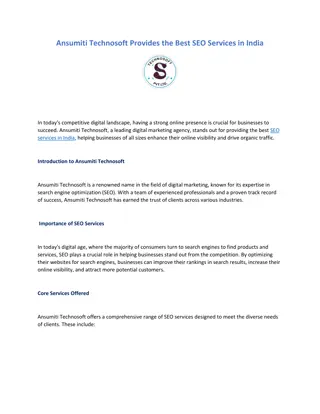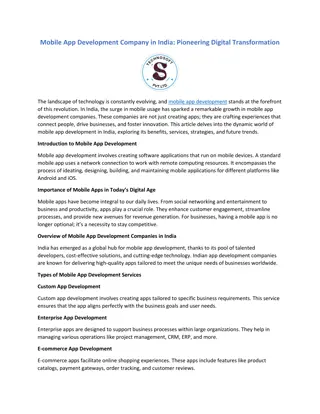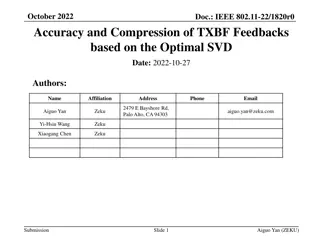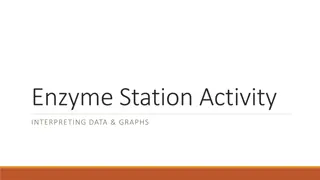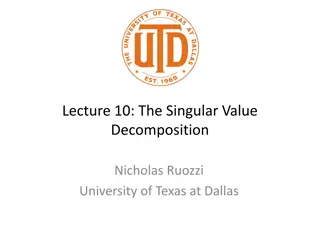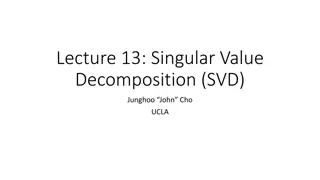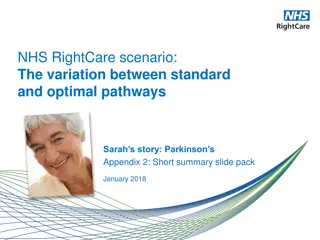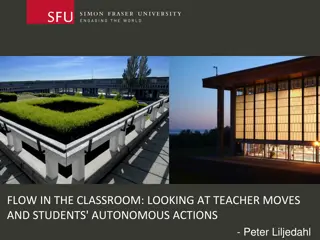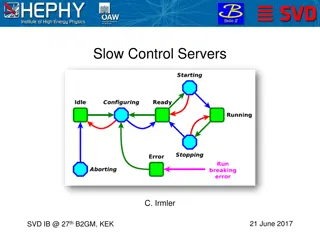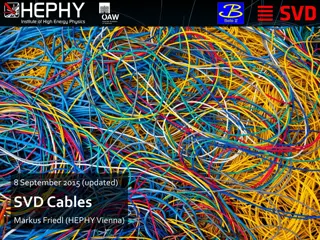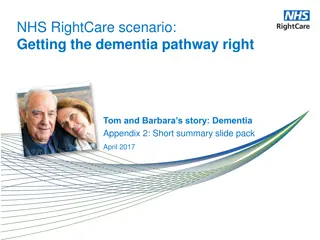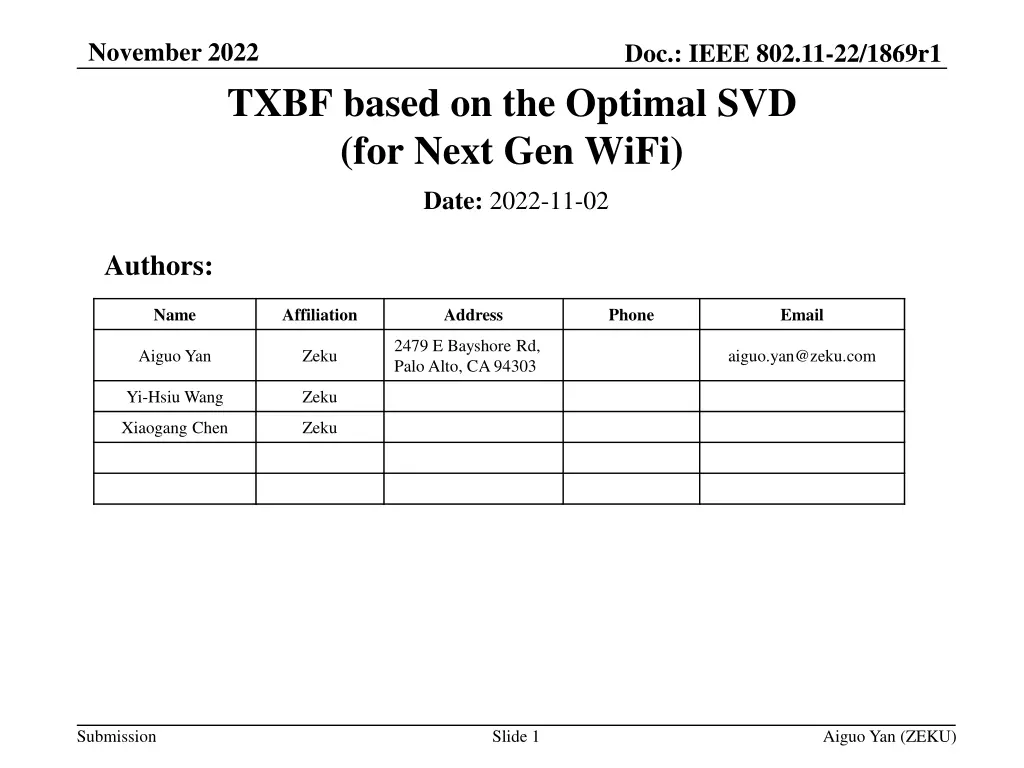
Optimal SVD-Based TXBF for Next Gen WiFi
Explore the advancements in IEEE 802.11 standards with Optimal Singular Value Decomposition (SVD) for Transmit Beamforming (TXBF) in next-generation WiFi. Discover how this technique enhances reliability, reduces latency, and improves throughput, along with potential standard changes for better WLAN connectivity. Uncover the benefits of feedbacking Optimal V matrices and considerations for improving TXBFing for enhanced performance.
Download Presentation

Please find below an Image/Link to download the presentation.
The content on the website is provided AS IS for your information and personal use only. It may not be sold, licensed, or shared on other websites without obtaining consent from the author. If you encounter any issues during the download, it is possible that the publisher has removed the file from their server.
You are allowed to download the files provided on this website for personal or commercial use, subject to the condition that they are used lawfully. All files are the property of their respective owners.
The content on the website is provided AS IS for your information and personal use only. It may not be sold, licensed, or shared on other websites without obtaining consent from the author.
E N D
Presentation Transcript
November 2022 Doc.: IEEE 802.11-22/1869r1 TXBF based on the Optimal SVD (for Next Gen WiFi) Date: 2022-11-02 Authors: Name Affiliation Address Phone Email 2479 E Bayshore Rd, Palo Alto, CA 94303 Aiguo Yan Zeku aiguo.yan@zeku.com Yi-Hsiu Wang Zeku Xiaogang Chen Zeku Submission Slide 1 Aiguo Yan (ZEKU)
November 2022 Doc.: IEEE 802.11-22/1869r0 Outline 1. Background 2. Application of the Optimal SVD in TXBFing 3. Potential changes for the new standards 4. Simulation Results of the Optimal SVD Based TXBF 5. Summary 6. Reference 7. Backup Slides Submission Slide 2 Aiguo Yan(ZEKU)
November 2022 Doc.: IEEE 802.11-22/1869r0 Background Objectives of UHR/SG [WNG02,WNG03] 1. Improve reliability of WLAN connectivity, 2. reduce latencies, 3. increase manageability, 4. increase throughput including at different SNR levels and 5. reduce device level power consumption. Some Key takeaways from Sept/2022 Meetings [UHR01,UHR02] 1. Features which address multiple objectives would be considered with higher priority. Background and Advantage of the Optimal SVD based TXBF [WNG01] 1. We had a high-level presentation in WGN in Sept/2022 2. We received many suggestions/comments/questions. 3. Many were eager to see simulations results 4. Now, simulation are showing 2.1 - 2.9 dB gains on average. 5. This kind of gain can be translated into multiple benefits Submission Slide 3 Aiguo Yan (ZEKU)
November 2022 Doc.: IEEE 802.11-22/1869r0 Optimal SVD Based TXBFing (hide standards-related details temporarily) = = = = H H H Optimal SVD: 1. SVD is not unique. 2. Choose a SVD that meets our pre-defined optimization criteria. H U SV U SV U SV ( ) = = H H ; diag exp ( ,:) V V D V D D j V end Preference: Smoothness of BFed Channel BF Feedback { ? ? } : ( ) Feedback V k Raw Channel { ? ? } BFer BFee : ( ) ( ) BFed Channel H k V k BFed Channel Filtering BFed Channel { ? ? ? ? } Submission Slide 4 Aiguo Yan (ZEKU)
November 2022 Doc.: IEEE 802.11-22/1869r0 Optimal SVD Based Feedbacks (see another presentation for details) Optimal SVD: 1. SVD is not unique. 2. Choose a SVD that meets our pre-defined optimization criteria. = = = H H H H U SV U SV U SV BF Feedback { ? ? } Preference: Smoothness of ( ) V k : ( ) Feedback V k Raw Channel { ? ? } BFer BFee : ( ) ( ) BFedChannel H k V k BFed Channel { ? ? ? ? } Submission Slide 5 Aiguo Yan (ZEKU)
November 2022 Doc.: IEEE 802.11-22/1869r0 Current Situation in Standards and Potential Changes The Normalized V matrices (i.e., the last row is non- negatively real) are feedbacked The best V matrices for either BFed channel or V re- construction are often not the normalized V matrices 1. 2. Potential Changes to Consider 1. Enable feedback of the Optimal V matrices 2. Limit freedom of TXBFers on re-construction of pro-coding matrices 3. Improve Sounding Accuracy 4. Submission Slide 6 Aiguo Yan (ZEKU)
November 2022 Doc.: IEEE 802.11-22/1869r0 Optimal SVD based BFing (11AX PER with the Channel-B) Proof of Concept here. Further optimization is possible. Slide 7 Submission Aiguo Yan (ZEKU)
November 2022 Doc.: IEEE 802.11-22/1869r0 Optimal SVD based BFing (11ax PER with the Channel-D) Submission Slide 8 Aiguo Yan (ZEKU)
November 2022 Doc.: IEEE 802.11-22/1869r0 Summary 1. Introduced essences of the Optimal SVD and its application to TXBFing 2. Shared performance simulation results of the Optimal SVD based TXBF, along with BFed channel est smoothing. 3. There always exist Multiple Options on detailed implementations and/or standardizations. 4. Is further analyzing if and what kind of helps from standardization is required Submission Slide 9 Aiguo Yan (ZEKU)
November 2022 Doc.: IEEE 802.11-22/1869r0 Selected References 1. [WNG01]: 11-22-1413-01-0wng-thoughts-on-high-reliability-communications , [Aiguo Yan and et al of Zeku] 2. [WNG02]: 11-22-0708-03-0wng-beyond-be-next-step, [Rolf De Vegt and et al of Qualcomm] 3. [WNG03]: 11-22-0418-00-0wng-considerations-of-next-generation-beyond-11be (Jianhan Liu and et al of MediaTek). 4. [UHR01]: 11-22-1567-00-0uhr-c-ofdma-throughput-analysis-in-various-mesh-backhaul-scenarios.pptx (Sigurd Schelstraete and et al.) 5. [UHR02]: 11-22-1566-00-0uhr-views-on-uhr.pptx (Sigurd Schelstraete and et al.) 6. [TXBF01]: C. Shen and M. P. Fitz, "MIMO-OFDM Beamforming for Improved Channel Estimation," in IEEE Journal on Selected Areas in Communications, vol. 26, no. 6, pp. 948-959, August 2008, doi: 10.1109/JSAC.2008.080811. 7. [TXBF02]: W. Hu, F. Li and Y. Jiang, "Phase Rotations of SVD-Based Precoders in MIMO-OFDM for Improved Channel Estimation," in IEEE Wireless Communications Letters, vol. 10, no. 8, pp. 1805-1809, Aug. 2021, doi: 10.1109/LWC.2021.3081583. 8. [TXBF03]: E. Jeon, M. Ahn, S. Kim, W. B. Lee and J. Kim, "Joint Beamformer and Beamformee Design for Channel Smoothing in WLAN Systems," 2020 IEEE 92nd Vehicular Technology Conference (VTC2020-Fall), 2020, pp. 1-6, doi: 10.1109/VTC2020-Fall49728.2020.9348441. 9. [TXBF04] F. Jiang, Q. Li and X. Chen, "Channel Smoothing for 802.11ax Beamformed MIMO-OFDM," in IEEE Communications Letters, vol. 25, no. 10, pp. 3413-3417, Oct. 2021, doi: 10.1109/LCOMM.2021.3099167. 10.[TXBF05]: Yi Jiang, J. Li and W. W. Hager, "Joint transceiver design for MIMO communications using geometric mean decomposition," in IEEE Transactions on Signal Processing, vol. 53, no. 10, pp. 3791-3803, Oct. 2005, doi: 10.1109/TSP.2005.855398. Submission Slide 10 Aiguo Yan (ZEKU)
November 2022 Doc.: IEEE 802.11-22/1869r0 Backup Submission Slide 11 Aiguo Yan (ZEKU)
November 2022 Doc.: IEEE 802.11-22/1869r0 Importance of GMD based TXBFing 1. The idea of Unequal MCS (originally proposed in 802.11n) is gaining additional attention for the next gen standard. 2. GMD based TXBFing is an alternative to Unequal MCS technique. 3. The essence of the Optimal SVD based TXBFing can be extended to the Optimal GMD based TXBFing. Submission Slide 12 Aiguo Yan (ZEKU)
November 2022 Doc.: IEEE 802.11-22/1869r0 Optimal GMD Based TXBFing (hide standards-related details temporarily) = = = H H H U SV QRP = Optimal GMD: 1. GMD is not unique. 2. Choose a GMD that meets our pre-defined optimization criteria. H H U RV U RV NotationAbuse Preference: Smoothness of BFed Channel BF Feedback { ? ? } : ( ) Feedback V k Raw Channel { ? ? } BFer BFee : ( ) ( ) BFed Channel H k V k Channel Est Smoothing BFed Channel { ? ? ? ? } Submission Slide 13 Aiguo Yan (ZEKU)
November 2022 Doc.: IEEE 802.11-22/1869r0 Optimal GMD Based TXBF Feedback (hide standards-related details temporarily) = = = H H H U SV QRP = Optimal GMD: 1. GMD is not unique. 2. Choose a GMD that meets our pre-defined optimization criteria. H H U RV U RV NotationAbuse Preference: Smoothness of the Feedback BF Feedback { ? ? } Raw Channel { ? ? } : ( ) Feedback V k BFer BFee : ( ) ( ) BFed Channel H k V k BFed Channel { ? ? ? ? } Submission Slide 14 Aiguo Yan (ZEKU)

